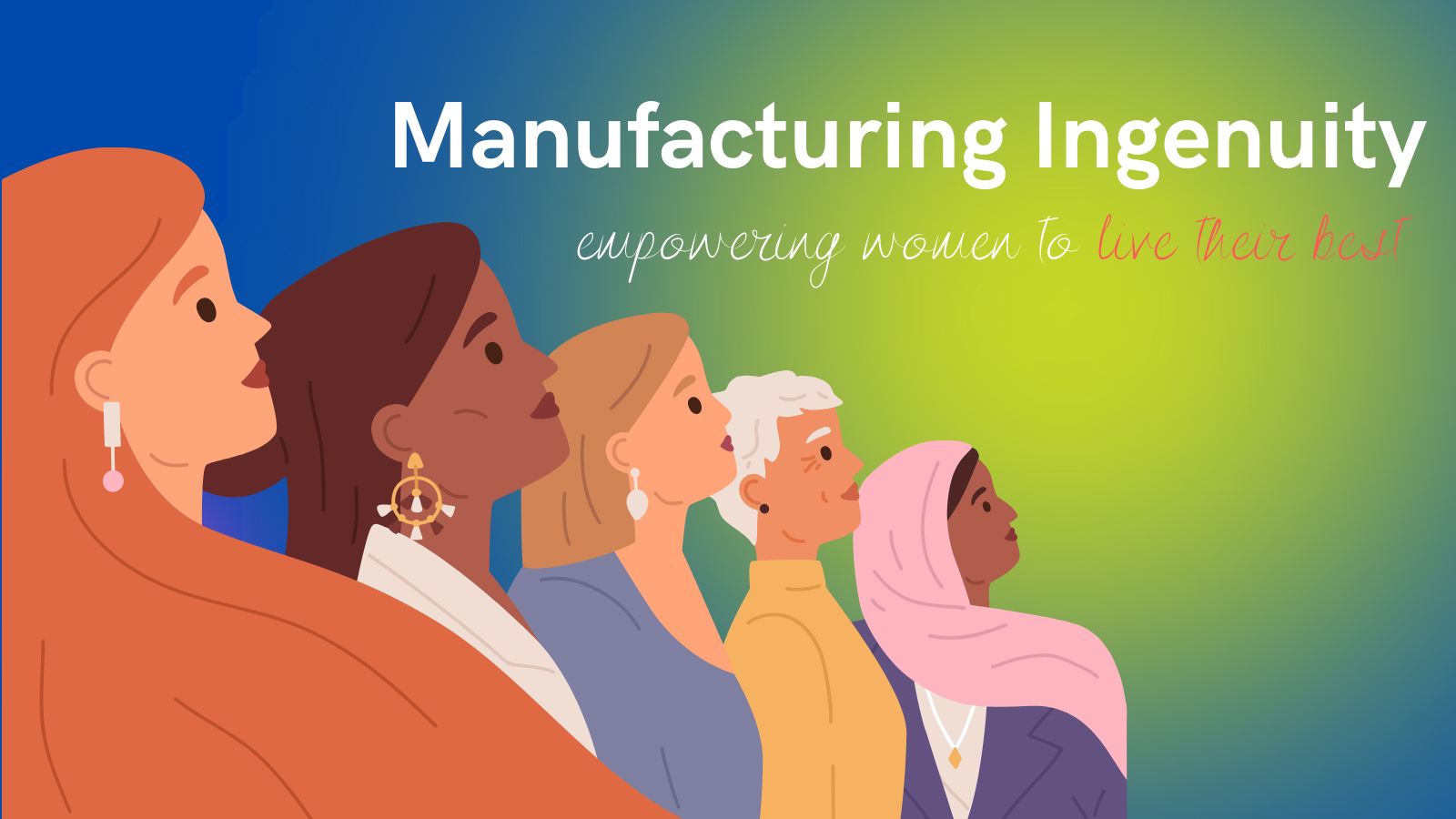
Nov 28, 2022
- People
- Feature Story
- Europe and CIS
- Konosuke Matsushita
- Business Policy
- Diversity Equity & Inclusion (DEI)

On March 7, 1918, Konosuke Matsushita founded* the Matsushita Electric Housewares Manufacturing Works, the predecessor of Panasonic. At various stages of history since its founding, Panasonic’s products and solutions have positively impacted the lives of people in Japan and around the world. Commemorating International Women’s Day on March 8, this article explores the impact of Panasonic products and solutions on the lives of women from the late 20th century to today.
“Improving people’s lives through creating goods needed for society or through providing wholehearted services are vitally important. After all, business is ultimately for the betterment of our society.”
— Konosuke Matsushita
Since 1960, there has been a rapid increase in the participation of women in the global labor market. In Japan’s post-war democracy, an atmosphere of women’s liberation and gender equality permeated the nation. In the midst of this period of high economic growth, people began to seek a “touch of affluence” in their lives. In tune with the zeitgeist, Panasonic developed a number of labor- and time-saving home technology products—washing machine, clothes dryer, and rice cooker, to name a few—to reduce the burden of housework on Japanese women in the hopes of enriching their lives.
In the late 1950s, black and white TVs, washing machines and refrigerators were known as the “three treasures” and the washing machine was the household appliance most coveted by women in Japan. In those days, Japanese women used a tub and their bare hands to scrub the laundry clean—a time-consuming, thankless task.
After studying the home appliance market in the United States, Konosuke Matsushita became convinced that the washing machine was a critically important product that could unshackle women from the heavy burden of housework. He promptly rolled up his sleeves and set about developing a washing machine. The first model emerged in 1951, but the company continued to make improvements, and by 1957 it had succeeded in producing a washing machine that ordinary households could afford. Further refinements led to the development of two-tub and then fully automatic washing machines in the decades to come.

One of the first washing machines, developed in 1957
In 1950s Japan, it was still common to dry laundry outside, and gray skies, bad weather, and the annual rainy season were a constant source of trouble. To reduce the disruption caused by inclement weather, Panasonic introduced Japan’s first electric clothes dryer in 1959. Over the decades, Panasonic continued to develop washing machines and clothes dryers side-by-side, and in 2000, it commercialized the world’s first upright washer-dryer unit. The company was also credited with popularizing the idea that “doing the laundry” meant both “washing” and “drying.”

The first electric clothes dryer (MK-800)
Cooking rice—staple of the Japanese diet—had long been an arduous task. Japanese people, especially women, were stuck by the stove for an hour every morning, adjusting the heat as they prepared rice for breakfast. To relieve them of this burden, Panasonic developed the electrical automatic rice cooker, which could cook rice at the flip of a switch. The product passed a strict review by the City of Los Angeles Building & Safety Electrical Test Laboratory, earning the coveted “LA” (Laboratory Approval) certification. The SR series was later exported to markets in Asia, and became a groundbreaking innovation that reduced the burden of housework for women in countries where rice is the principle foodgrain.

The first automatic electric rice cooker (SR-15)
“Don’t make what the customer wants. Create products that delight customers”
— Konosuke Matsushita
In the 1990s, as a part of its commitment to promoting diversity in Japan, Panasonic established internal systems targeting greater balance between work and home life, including childcare and nursing care support, to help women take more active roles on the front lines of business. In the early 2000s, when the ratio of dual-income households in Japan exceeded that of households with full-time housewives for the first time, the company established the Corporate Equal Partnership Division and the management policy was revised to include promotion of women managers as a fundamental policy, leading to recognition by the Japanese government as an equal opportunity company.
At Panasonic, the newly emerging segment for beauty appliances, known as Panasonic Beauty, became one of the markets that was pioneered and matured by women.

Beginning in the latter half of the 1980s, hair dryer development shifted from “how to dry hair quickly” to “how to eliminate damage and promote healthy hair.” At that time, Panasonic’s product planning, development, and marketing departments were mostly led by male employees and technical experts. But with greater emphasis on female empowerment within the company, women gradually began to voice their ideas and opinions with confidence—a change that had a notable impact on product development and marketing.
One day, a Panasonic employee was inspired to apply her “ion facial steamer” to her hair for treatment and the results led to a project to develop a hair dryer using negative ions. Through trial and error and a number of design revisions, the company finally released the first hair dryer with negative ion capability in 2001.
Following the success of negative ion dryers, the company developed a next-generation series, known as “nanocare™,” that featured nanoe™ charged water particles with deodorizing and purifying characteristics. With women influencing the marketing strategy for the nanocare series, Panasonic was able to raise awareness in Japan and gain a share of the Chinese market.

nanocare™ (EH5421)
“Our fundamental duty in producing goods is to bring happiness to our customers with products that are considerate, charming, graceful, and fulfilling.”
— Konosuke Matsushita
Under COVID-19, people started to rely more heavily on digital technology while working at home or socializing with family and friends online. The pandemic also changed the way people think about the integration of work and life. In today’s highly digitalized society, Panasonic is bringing digital and IOT solutions to home-tech products, offering “life-tech” that leverages the power of digital to support the well-being of our diverse customers and help them live their best.

Yohana, a Panasonic subsidiary, launched its Modern Family Concierge Service in Seattle in 2021 and expanded to the nationwide in the United States in the following year. Through this modern family concierge service, members pay a monthly subscription fee, and in return, they are paired with a team of specialists, researchers, and a dedicated guide for ongoing support with ever growing to-do lists and demands of modern life via mobile app. By delegating routine tasks to their Yohana team, busy families can spend more time focused on their families or fulfilling personal goals. Under founder Yoky Matsuoka’s leadership, Yohana is now rolling out its service in Japan.

The products covered in this article are just a small sampling of Panasonic’s century-long history of manufacturing ingenuity. To learn more about the history of Panasonic products, visit the Panasonic Museum Hall of Manufacturing Ingenuity website.
*Panasonic celebrates the anniversary of the company’s founding on May 5. On this day, Konosuke Matsushita declared the far-reaching mission of Matsushita Electric, marking the official start of the company. Every year, May 5 is celebrated as “Meichi,” the day the founder and employees awakened to their corporate mission.
Disclaimer: Please note that the products introduced in this article are for historical reference; some are no longer being produced or sold.
The content in this website is accurate at the time of publication but may be subject to change without notice.
Please note therefore that these documents may not always contain the most up-to-date information.
Please note that German, French and Chinese versions are machine translations, so the quality and accuracy may vary.